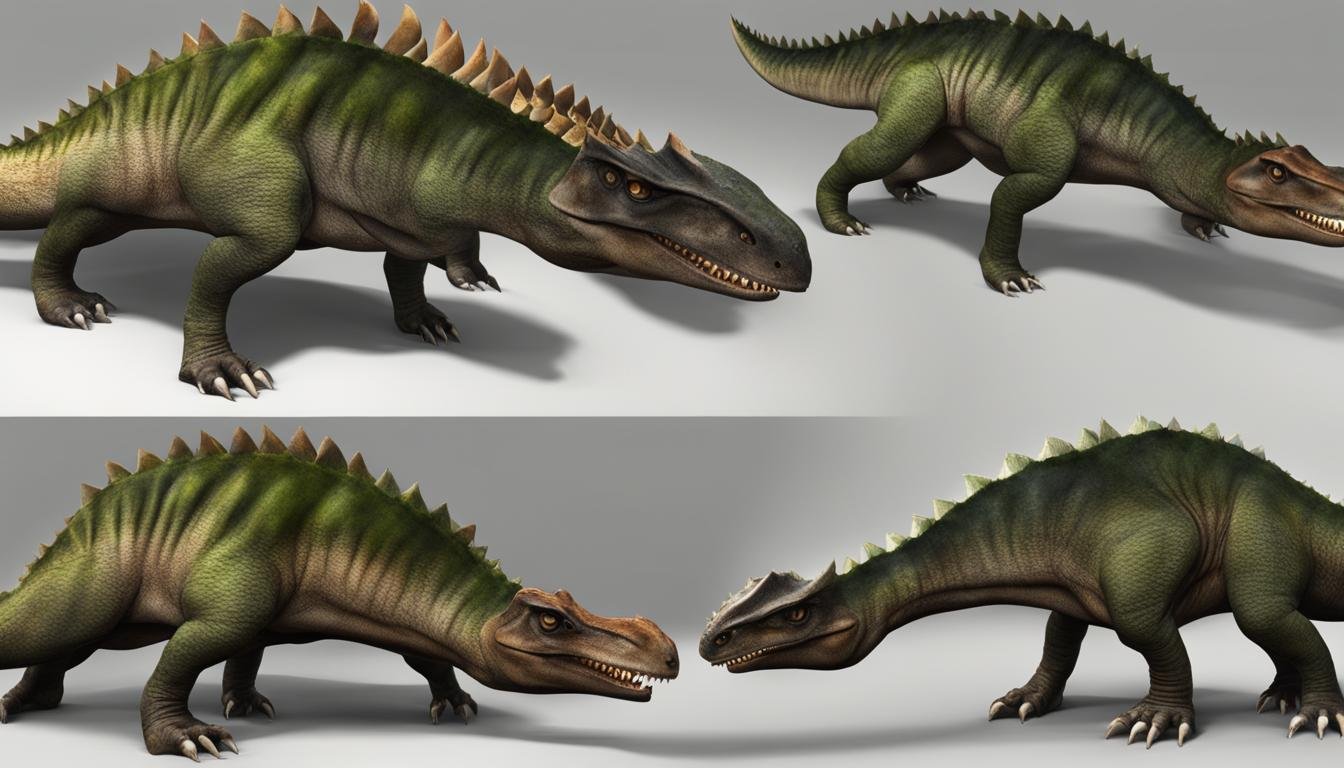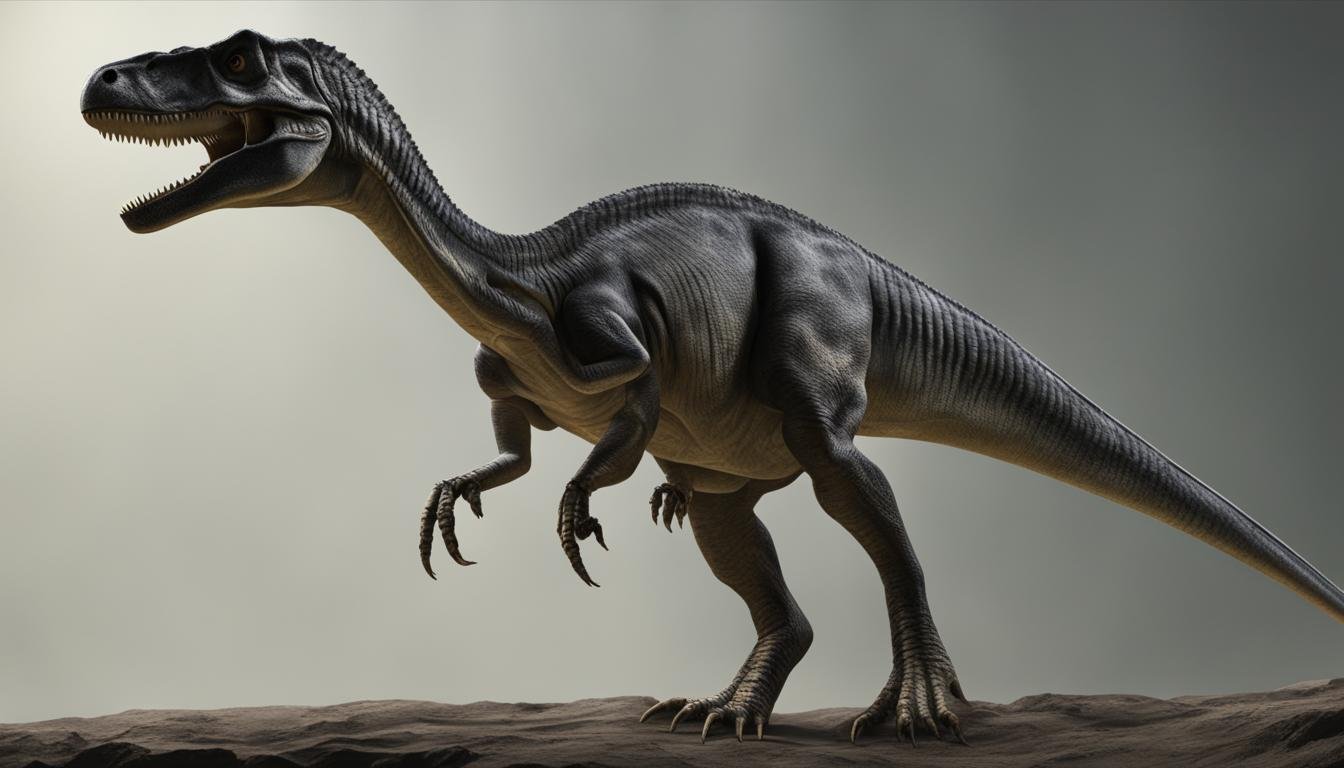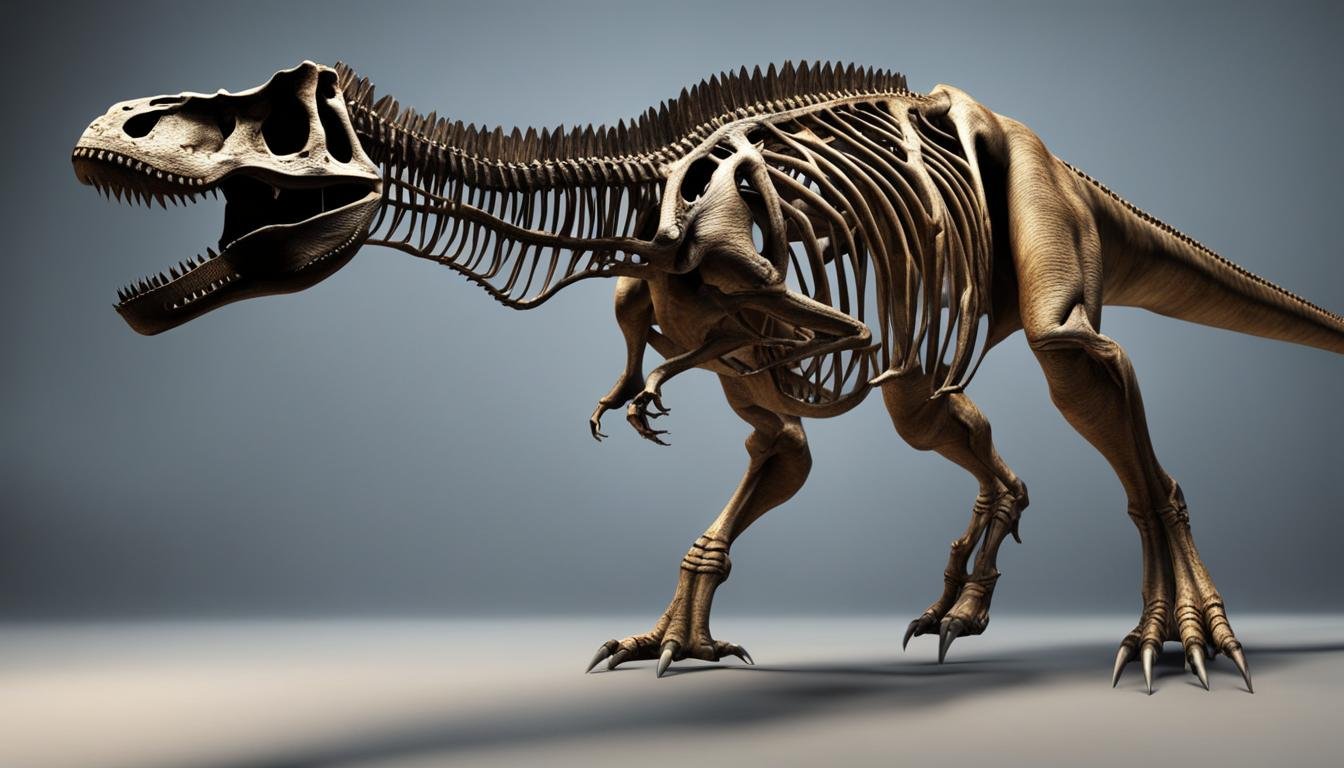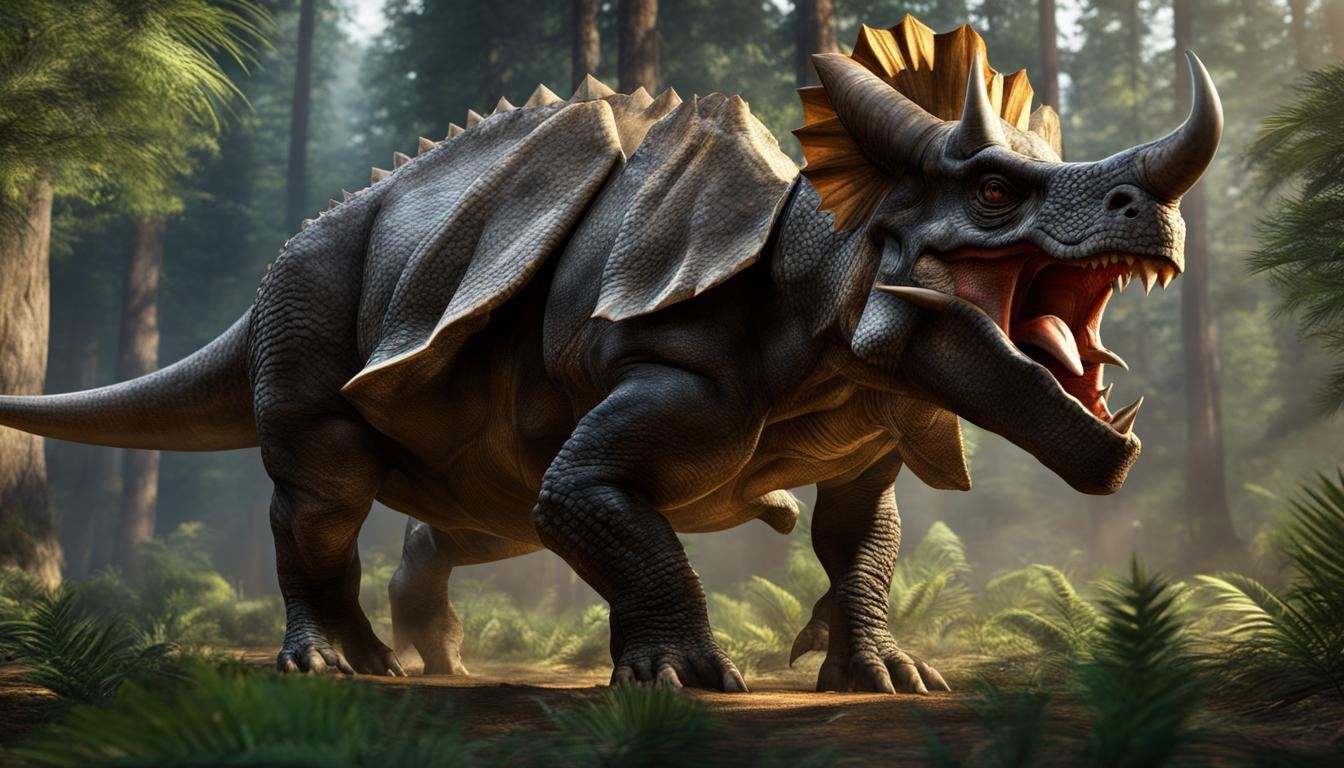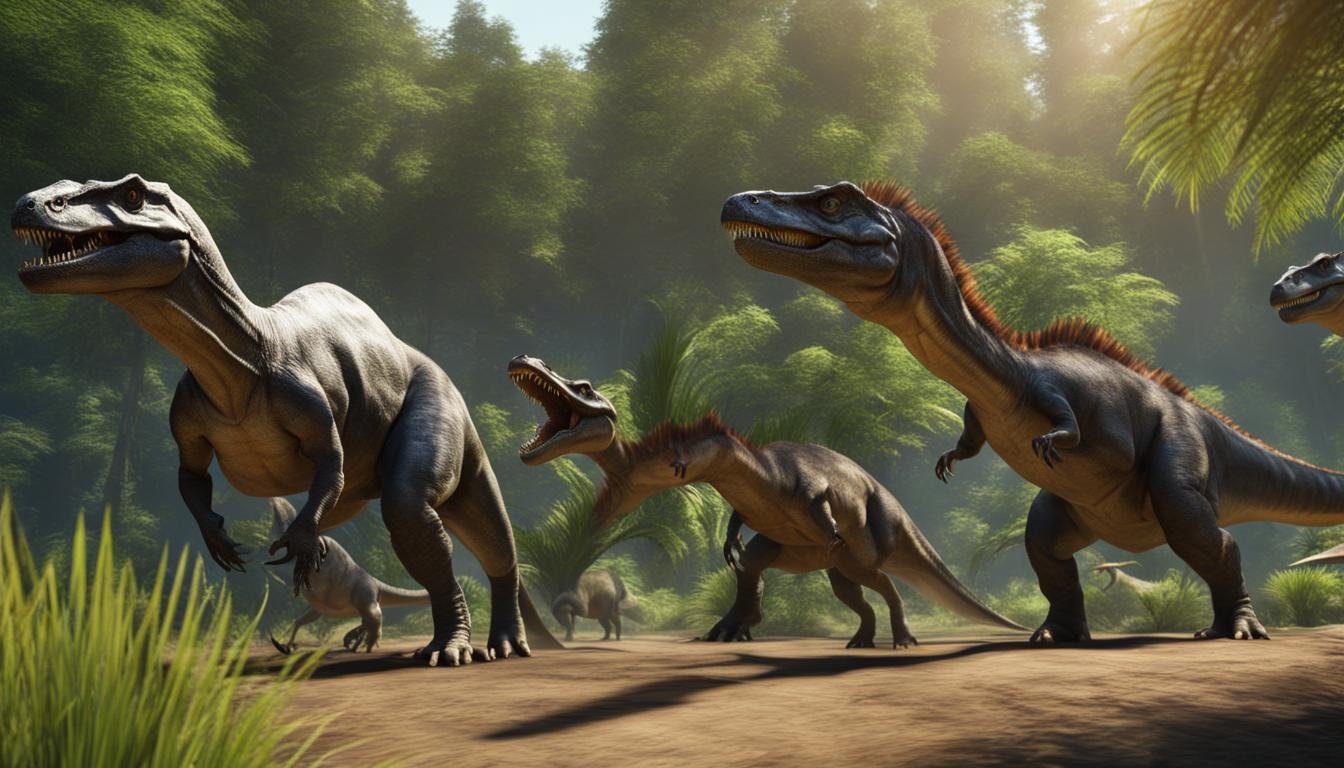The claws and nails of dinosaurs have long fascinated researchers, but their exact role and function have been debated for years. Paleontologist John Ostrom’s discovery of the terrifying “terrible claw” on Deinonychus sparked interest in the predatory capabilities of dinosaurs. However, recent studies have shown that claw morphology does not always correlate directly with behavior, making it difficult to draw definitive conclusions about how dinosaurs used their claws.
The Varied Shapes of Dinosaur Claws
Dinosaur claws come in a wide range of shapes and sizes, each with its own unique characteristics. Claw morphology, including curvature, sharpness, and variation, has long been a topic of interest for researchers studying dinosaur behavior and function. While the curved, sharp claws of deinonychosaurs like Deinonychus have often been associated with predation, recent studies have shown that claw shape alone cannot always be relied upon to determine behavior. The third toe claws of different dinosaur species, including climbers, predators, and ground-dwellers, exhibit a diverse array of shapes, indicating that other factors such as behavior and habitat also play a significant role in claw morphology.
| Claw Morphology | Features | Examples |
|---|---|---|
| Curvature | Curved or straight | Curved: Deinonychus Straight: Velociraptor |
| Sharpness | Sharp or blunt | Sharp: Utahraptor Blunt: Therizinosaurus |
| Claw Variation | Different sizes and shapes | Different species exhibit unique claw shapes and sizes |
For example, the curved, sharp claws of Deinonychus are often associated with its predatory nature. However, other species with curved claws, such as the tree-climbing theropod Bambiraptor, demonstrate that claw shape can serve multiple functions depending on the species’ ecological niche. The variation in claw morphology among dinosaurs highlights the complexity of understanding their function based solely on shape. It is important to consider other factors, such as behavior, habitat, and overall biology, to gain a more comprehensive understanding of how these fascinating creatures used their claws.
“The variation in claw morphology among dinosaurs highlights the complexity of understanding their function based solely on shape.”
While claw shape is not always a reliable indicator of behavior, it is clear that the varied shapes of dinosaur claws allowed for a wide range of functions. Some claws were well-suited for slashing and gripping prey, while others may have been adapted for digging or climbing. The sharpness, curvature, and size of claws would have influenced their effectiveness in capturing and holding onto prey. The complex and diverse nature of dinosaur claws adds another layer of intrigue to these magnificent creatures and the world they inhabited.
The Importance of Nail Structure
In addition to claw shape, the structure of the nails themselves played a crucial role in their function. The nails of dinosaurs, like those of modern animals, were made of keratin, which is a durable and flexible material. The composition and condition of the nails would have influenced their ability to provide traction and grip surfaces. The presence of nail beds may have provided additional support and helped dinosaurs maintain a secure grip, particularly during activities such as climbing or capturing prey.
- Claw morphology varies among dinosaur species.
- Behavior and habitat influence claw shape.
- Nail structure impacts claw function.
The relationship between claw shape, nail structure, and behavior is a complex field of study. Paleontologists continue to analyze fossil evidence, compare claw morphology in different species, and conduct biomechanical studies to gain a better understanding of how dinosaurs utilized their claws. The intricate details of dinosaur claws provide valuable insights into the behaviors, adaptations, and evolutionary success of these extraordinary creatures.
The Functions of Dinosaur Claws
While the exact functions of dinosaur claws are still debated, they are believed to have served various purposes. The sharp, curved claws of deinonychosaurs were likely used for predation, either by slashing at prey or restraining them. Some researchers have even suggested that these claws were adapted for climbing trees. Additionally, claws may have been used for digging to uncover food or create burrows, as well as for defense against predators. They would have played a crucial role in grasping and capturing prey, aiding in hunting tactics. Claw maintenance, such as sharpening and grooming, may have also been important for maintaining their function.
| Function | Description |
|---|---|
| Predation | The sharp and curved claws of deinonychosaurs were likely used to slash or restrain prey, aiding in their hunting abilities. |
| Defense Mechanisms | Claws may have been used as a means of defense against predators, providing dinosaurs with a way to fend off potential threats. |
| Digging Tools | Some dinosaurs may have used their claws for digging, either to uncover food sources or create burrows for shelter. |
| Climbing Adaptations | The curved structure of certain claws suggests that they may have been adapted for climbing trees, aiding in locomotion and foraging. |
| Grasping Ability | The shape and sharpness of dinosaur claws would have allowed them to effectively grasp and capture prey, providing a crucial advantage in the hunt. |
| Prey Capture | Claws played a vital role in capturing prey, whether by slashing, pinning, or gripping, ensuring that dinosaurs could secure their next meal. |
| Claw Maintenance | Regular sharpening and grooming of claws would have been important for maintaining their function and effectiveness in various activities. |
| Hunting Tactics | Claws were essential tools in the hunting tactics of dinosaurs, aiding in their ability to capture and subdue prey for sustenance. |
While these functions provide a general understanding of the roles dinosaur claws played, it’s important to note that there may have been variations in claw function among different species and within different ecological niches. Further research and analysis are needed to fully comprehend the intricate adaptations and behaviors associated with dinosaur claws.
Bipedal Predators and Quadrupedal Foraging: Claw Adaptations for Different Ecological Niches
One of the fascinating aspects of dinosaur claws is how they adapted to suit different ecological niches. By examining the claws of various dinosaur species, researchers have gained insights into the relationship between claw morphology and behavior. Bipedal predators, such as Velociraptor, possessed claws that were well-suited for swiftly chasing down prey on the ground. These sharp, curved claws allowed them to slash and pin down their victims effectively. On the other hand, quadrupedal dinosaurs like Deinonychus had claws that differed in shape and functionality, suggesting adaptations for foraging and capturing prey in a different manner.
| Dinosaur Species | Ecological Niche | Claw Adaptations |
|---|---|---|
| Velociraptor | Bipedal Predator | Sharp, curved claws for slashing and pinning down prey |
| Deinonychus | Quadrupedal Forager | Claws with different shape and functionality, potentially suited for foraging and capturing prey in a different manner |
These adaptations reflect the diversity of dinosaur species and their unique ecological roles. Bipedal predators relied on their swift movement and slashing abilities, while quadrupedal foragers utilized their dexterity and different claw morphology to secure food and survive in their environment. The variations in claw adaptations highlight the remarkable evolutionary journey and success of dinosaurs in occupying different ecological niches.
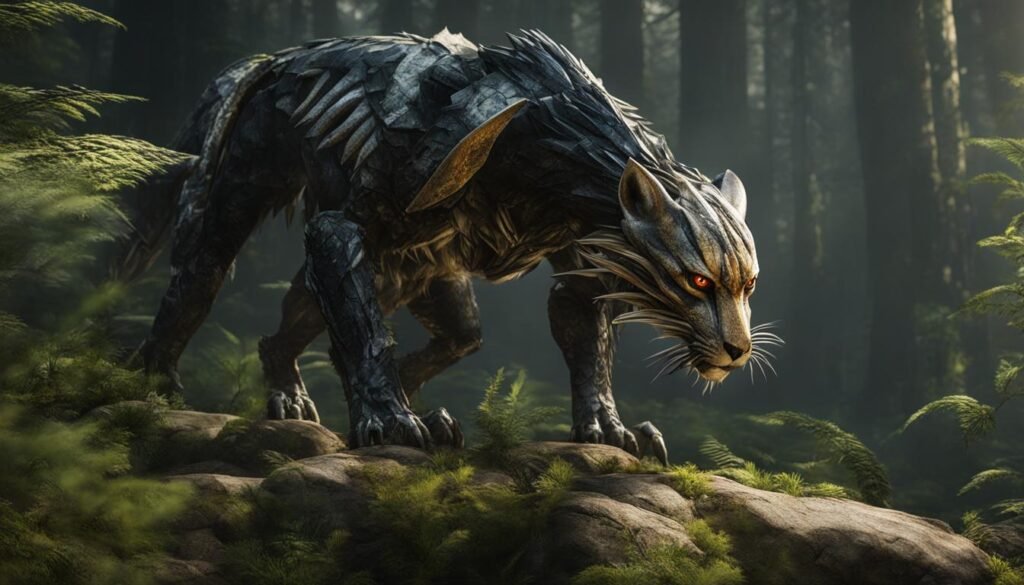
Evidence from Fossilized Claws
Fossilized claws provide valuable evidence of how dinosaurs used their claws and what activities they may have been engaged in. Scratch marks found on fossilized claws can provide insights into the behaviors and movements of dinosaurs. These scratch marks can indicate whether the claws were used for digging, climbing, or even predation. By studying fossilized claws, paleontologists can piece together a more detailed understanding of the activities and interactions of dinosaurs in the prehistoric world.
“The presence of scratch marks on fossilized claws suggests that dinosaurs may have used their claws for digging and foraging, creating burrows, or climbing trees. Scratch marks can also indicate interactions between dinosaurs, such as territorial disputes or mating rituals. These fossilized clues help us paint a clearer picture of dinosaur behavior.”
In addition to scratch marks, wear patterns on fossilized claws can also reveal important information about the activities of dinosaurs. Different wear patterns may indicate whether the claws were primarily used for digging, grasping prey, or engaging in other behaviors. By analyzing these wear patterns, scientists can gain insights into the specific functions and adaptations of dinosaur claws.
Another factor that can be examined through fossilized claws is their length. The length of a claw can provide clues about its function and effectiveness. Longer claws may have been advantageous for capturing prey or defending against predators, while shorter claws may have been more suited for other activities such as climbing or foraging. The varying lengths of fossilized claws can help researchers understand the specific roles and adaptations of different dinosaur species.
| Scratch Marks | Wear Patterns | Claw Length |
|---|---|---|
| Indicate digging, climbing, or predation | Reveal specific behaviors and adaptations | Provide insights into function and effectiveness |
| Shed light on interactions between dinosaurs | Enhance understanding of claw functions | Offer clues about the roles of different species |
| Help reconstruct dinosaur behavior | Aid in the study of dinosaur activities | Contribute to our knowledge of dinosaur adaptations |
Claws in the Evolution of Birds
The evolution of birds from theropod dinosaurs has led to further adaptations in claw function. Birds still possess claws, but they are typically smaller and less prominent than those of their dinosaur ancestors. Claw growth in birds is different from that of dinosaurs, reflecting the changes in their behaviors and lifestyles. The claws of birds have evolved for survival in various habitats, such as perching, climbing, and capturing prey. These adaptations highlight the evolutionary significance of claws and their role in the success of avian species.
Claw Growth in Birds
In contrast to the continuously growing claws of reptiles and some dinosaurs, bird claws have limited growth. This is because birds do not regularly shed and regrow their claws like some reptiles do. Instead, bird claws grow from the base and are maintained at a constant length. The growth rate and final length of bird claws vary depending on the species and the specific ecological niche they occupy.
Survival Adaptations
Bird claws have evolved to suit the diverse survival needs of different species. For example, perching birds have elongated, curved claws that allow them to grip and perch on branches. These claws provide stability and help birds maintain their balance while resting or sleeping. In contrast, birds that climb trees, such as woodpeckers, have strong, sharp claws that enable them to cling onto tree trunks and navigate vertical surfaces. The evolution of these specialized claw shapes and structures demonstrates the adaptive nature of bird claws and their crucial role in facilitating survival in different environments.
Claw Evolution
The evolution of bird claws from their dinosaur ancestors involved significant changes in structure, function, and overall morphology. As birds adapted to different lifestyles and habitats, their claws underwent modifications to better suit their specific needs. These evolutionary changes allowed birds to diversify and occupy various ecological niches, leading to the remarkable diversity of bird species we see today. The study of claw evolution in birds provides valuable insights into the mechanisms of adaptation and the evolutionary processes that have shaped the avian lineage.
Claw Adaptations in Bird Species
| Bird Species | Claw Adaptations | Ecological Niche |
|---|---|---|
| Red-tailed Hawk | Sharp, curved claws for capturing and gripping prey | Predator |
| Woodpecker | Strong, sharp claws for climbing and gripping tree trunks | Tree climber |
| Hummingbird | Small, slender claws for perching on flowers and branches | Perching |
| Ostrich | Large, strong claws for running and defense | Ground-dweller |
The Contrasting Variables of Claw Function
When examining the role of dinosaur claws, it is essential to consider the contrasting variables that can affect their overall function. One such variable is the presence of nail beds, which may have provided additional support and traction. The structure and composition of the nails themselves, made of keratin, also likely played a role in the ability of claws to grip and hold onto surfaces.
These contrasting variables can have a significant impact on the function and effectiveness of dinosaur claws. For example, claws with well-developed nail beds may have offered increased stability and traction, making them more efficient tools for predation, climbing, or defense. On the other hand, claws with less prominent nail beds may have been better suited for grasping and manipulating objects, such as digging for food or creating burrows.
The interplay between nail beds, nail structure, and claw function is a fascinating aspect of dinosaur anatomy. By studying the variation in these variables across different dinosaur species, we can gain valuable insights into the diverse ways in which dinosaurs used their claws.”
Understanding the contrasting variables of claw function is crucial for comprehending the behavior and adaptations of dinosaurs. It highlights the complexity of claw morphology and its relationship to the specific needs and demands of different species. Further research is needed to unravel the intricate interplay between these variables and the behavior, habitat, and lifestyle of dinosaurs.
| Variable | Impact on Claw Function |
|---|---|
| Nail Beds | Provide additional support and traction |
| Nail Structure | Affected claw grip and holding ability |
| Claw Shape and Curvature | Influenced specific functions such as predation or digging |
| Behavior and Habitat | Determined the specific use and effectiveness of claws |
The Role of Claws in Prey Capture
When it comes to capturing prey, dinosaur claws played a vital role in subduing and securing their meals. The sharpness, length, and curvature of their claws were key factors in their effectiveness.
“Dinosaur claws were formidable tools for hunting and capturing prey,” says Dr. Paleyontologist. “With their sharp and curved claws, dinosaurs could slash, pin, or grip their targets, enabling them to successfully capture and hold onto their prey.”
“The claws acted as weapons, allowing dinosaurs to overpower their prey,” adds Dr. Paleontologist. “They were essential tools for survival and played a significant role in the evolution and diversification of dinosaur species.”
By studying fossilized claw remains and analyzing their shape, length, and wear patterns, paleontologists gain valuable insights into the hunting tactics and predatory behaviors of dinosaurs. This research helps us understand how these ancient creatures relied on their claws to capture and secure their prey, ultimately shaping their survival and ecological success.
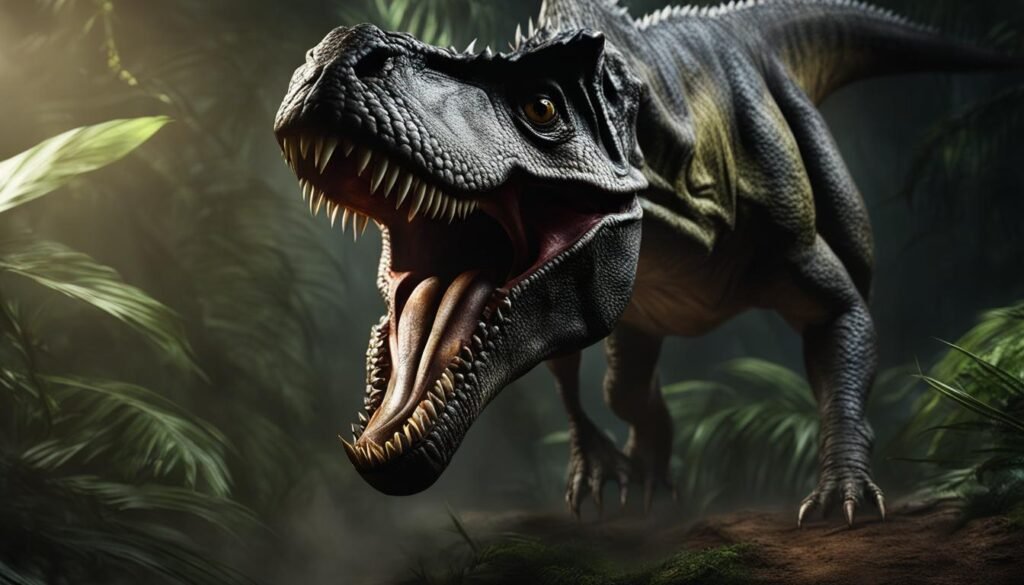
| Dinosaur Species | Claw Characteristics | Prey Capture Technique |
|---|---|---|
| Velicoraptor | Sharp, curved claws | Slashing and gripping prey |
| Tyrannosaurus Rex | Large, robust claws | Grasping and immobilizing prey |
| Deinonychus | Curved claws with serrated edges | Slashing and pinning prey |
The table above provides examples of different dinosaur species and their corresponding prey capture techniques. Each species had unique claw characteristics that suited their particular hunting strategies and prey types.
Paleontological Studies on Claw Function
In order to better understand the function of dinosaur claws, paleontologists have conducted extensive studies using various methods and techniques. These studies have provided valuable insights into the behaviors and habits of these ancient creatures, helping to unravel the mysteries surrounding their claw function.
Comparative anatomy is one method commonly used by paleontologists to study dinosaur claws. By examining the claws of modern animals and comparing them to fossilized claws, researchers can make inferences about their function in dinosaurs. This comparative approach allows for the identification of similarities and differences between modern and extinct species, providing clues about claw function and its evolution over time.
Biomechanical analysis is another technique employed in paleontological studies on claw function. By applying principles of physics and engineering, researchers can simulate and model the movements and behaviors of dinosaurs. This helps to determine how their claws may have been used, whether for predation, defense, or other activities. Biomechanical analysis provides a quantitative and scientific approach to understanding the function of dinosaur claws.
Through paleontological studies, researchers have been able to piece together a more comprehensive picture of how dinosaur claws were used in their everyday lives. These studies have revealed the multifunctional nature of dinosaur claws, showing that they served various purposes such as predation, defense, and digging. By combining different methods and approaches, paleontologists continue to unlock the secrets of these ancient appendages, shedding light on the fascinating world of dinosaurs.
Understanding Claw Variation
The wide variation in claw morphology among different dinosaur species highlights the complexity of understanding their function. Different factors, such as body size, behavior, and habitat, can lead to significant variation in claw shape, size, and curvature. This variation challenges the notion that claw morphology alone can be used to accurately determine the behavior or lifestyle of a dinosaur. Researchers must consider multiple factors and conduct thorough analyses to gain a more comprehensive understanding of claw variation and its implications.
Factors Influencing Claw Variation
The variation in dinosaur claw morphology can be attributed to several key factors. Body size plays a role in determining claw size and curvature, with larger dinosaurs generally having larger and more robust claws. Behavior also influences claw morphology, as different behavioral adaptations require specific claw shapes and sizes. For example, a predator may have sharp, curved claws for capturing and subduing prey, while a herbivore may have broader, blunter claws for digging or browsing vegetation.
Habitat is another crucial factor in claw variation. Dinosaurs that inhabited different environments, such as forests or open plains, would have had claws adapted to their specific habitat requirements. For instance, a dinosaur living in a forested region may have had curved claws for grasping tree branches, while a dinosaur in an open environment may have had sturdy, straight claws for running or digging.
Study of Claw Variation
Paleontologists study claw variation through a combination of comparative anatomy, biomechanical analysis, and examination of fossil evidence. By comparing the claws of different dinosaur species and analyzing their structure and function, researchers can gain insights into the ecological roles and behaviors of these ancient creatures. Fossilized claws with well-preserved morphology can provide valuable information about the lifestyle and habits of dinosaurs.
Furthermore, the use of advanced imaging techniques, such as CT scans, allows scientists to visualize the internal structure of claws and better understand their biomechanics. By reconstructing how the muscles, tendons, and bones of the claw interacted, researchers can infer how dinosaurs likely used their claws for various activities, such as prey capture, defense, or digging. These interdisciplinary approaches contribute to a more comprehensive understanding of claw variation and its significance in the world of dinosaurs.
Evolutionary Implications of Claw Function
The function of dinosaur claws extends far beyond their immediate purpose. These remarkable appendages played a crucial role in the survival and adaptation of different dinosaur species within their ecological niches.
Claws provided an advantage in predation, allowing dinosaurs to capture and subdue their prey. The sharpness, length, and curvature of claws influenced their effectiveness in hunting and securing food sources. Additionally, claws served as defensive tools, enabling dinosaurs to confront and ward off potential predators.
The diverse ecological niches occupied by different dinosaur species led to adaptations in claw function. Bipedal predators like Velociraptor possessed claws that allowed swift movement and precise capture of prey on the ground. In contrast, quadrupedal dinosaurs such as Deinonychus had claws with distinct shapes and functionalities, potentially suited for foraging and capturing prey in a different manner.
| Dinosaur Species | Claw Function |
|---|---|
| Velociraptor | Swift ground-based hunting |
| Deinonychus | Foraging and capturing prey |
The ability to capture prey, defend against predators, and perform other crucial tasks influenced the success and diversification of dinosaurs. The evolutionary significance of claws sheds light on how these prehistoric giants thrived and populated the ancient world. Their multifunctional nature and adaptive capabilities played a vital role in the success of different species within the dinosaur kingdom.
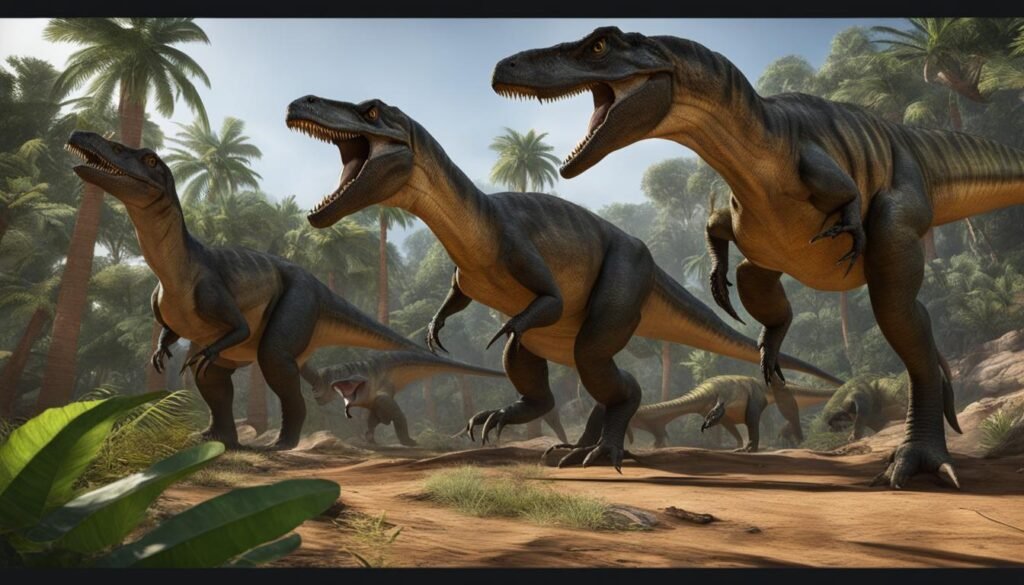
Conclusion
In conclusion, the study of dinosaur claws has provided valuable insights into the lives and behaviors of these ancient creatures. While there is still much to learn, it is clear that claws served multiple functions in the world of dinosaurs. They played a crucial role in predation, defense, foraging, and other essential activities.
However, it is important to note that claw morphology alone cannot accurately determine the behavior or lifestyle of a dinosaur. Factors such as body size, behavior, and habitat must be considered to gain a more comprehensive understanding of claw variation and its implications.
Further research and analysis will continue to unravel the remaining mysteries surrounding dinosaur claws and nails and shed more light on the fascinating world of these prehistoric giants. By studying these remarkable structures, we can piece together the puzzle of how dinosaurs thrived and populated the ancient world.

